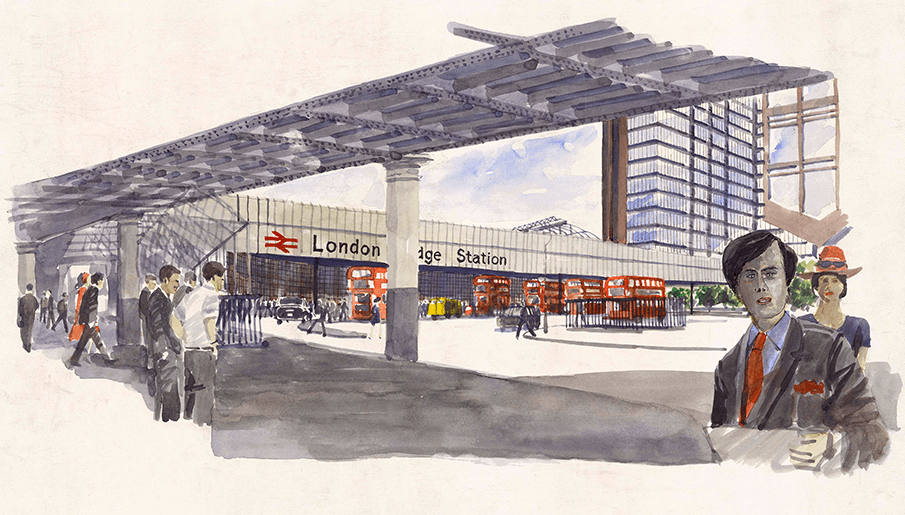The history of London Bridge station
London Bridge is the capital’s oldest railway station and has undergone many changes in its complex history.
It has always been a busy station and it has adapted to meet demand. Its story reflects the ambition, competition and conflict which characterised the development of the railway infrastructure in London.

The original London Bridge
The first station at London Bridge was opened at Tooley Street on 14 December 1836 by the London & Greenwich Railway (LGR), along with its line as far as Deptford.
The original station was not grand; a simple building providing a booking hall and company offices, and two platforms at the end of the new viaduct without a trainshed to cover passengers and trains.
It was only a small company, but the LGR realised its money could be made by leasing its line and terminus to the many railway companies wanting access to London from the south east.
Complicated agreements
The first agreement reached by the LGR was with the London & Croydon Railway (LCR). The LCR made use of LGR tracks, but in June 1839 the company opened its own station building to the north of the LGR station, setting in motion a complicated future of for London Bridge.
As more railways between London and the south east were authorised, further agreements were entered into by both the LGR and the LCR for access to London Bridge. By the 1840s four companies were now using the viaduct approach to the station and paying high tolls to the LGR per passenger to do so; to increase capacity the LGR widened the viaduct.
The arrangement of the busy lines going into London Bridge meant there was often a dangerous crossing of the tracks in order for trains to reach their respective sides of the station. So in 1844 the railway companies swapped stations; the now joint station of the London & Croydon, the London & Brighton and South Eastern railway companies was established in the London & Greenwich terminus to the south of the station site, while the London & Greenwich used the old London & Croydon station buildings to the north.
Company fall-outs
The combined companies set about demolishing the original LGR station to build a new joint terminus that could cope with demand. This new station opened in 1844 but was only partially built.
In 1846 the LCR and the London and Brighton railways merged to form the London Brighton & South Coast Railway. This new company could not agree future plans for the joint station with the South Eastern Railway, who left the partnership at London Bridge to establish its own station at Bricklayers Arms.
The LBSCR took over the unfinished joint station building and demolished it in 1849. Bricklayers Arms did not function well as a passenger station and the SER came back to London Bridge having agreed new terms with the LGR.
In 1850 the SER built a dividing wall, physically separating their north side of the London Bridge station site from the LBSCR, and set about building their own terminus. The LBSCR did the same on their south side of the site.
During the 1850s and 1860s traffic and passenger numbers at London bridge steadily increased as new lines were developed taking the railway further into the City and the west end.
In 1864 the SER side of the station turned into a through station with the line extension northwards and to the new SER terminus at Charing Cross. The LBSCR station remained a terminus with platforms added to cope with traffic associated with day trippers to the re-located Crystal Palace, and holidaymakers to Brighton.
The station comes together
In 1923 the Southern Railway took control of both stations and set to work uniting the two by opening out the dividing wall and building a footbridge between the two.
But the layout was still confusing and congested for passengers. In 1940 the station was damaged during a bombing raid the damage and repairs doing little to help the situation.
By the late 1960s London Bridge had once again reached capacity and British Rail undertook a major redevelopment of the station installing a new signalling scheme and new station concourse which included new office block accommodation and a new frontage which incorporated a bus station which opened in 1978.
A station for the 21st century
In the 21st century, the station once again found itself at the centre of major change. Since 2013 the Government-sponsored Thameslink Programme has transformed the station with a five-year, £1bn redevelopment, completed in 2018, to help meet the infrastructure demands of the future.
Improvements included new entrances on Tooley Street and St Thomas Street, a huge new concourse which unifies the station for the first time and step free access to every platform, following the installation of new lifts and escalators. The track layout at the station was also reconfigured and new platforms created to accommodate Thameslink trains.
The redevelopment is also ensuring that the station becomes a destination in its own right, with new shops, cafes, bars and restaurants all helping transform the surrounding area.
Following the redevelopment, London Bridge station was officially reopened by HRH Prince William, The Duke of Cambridge, on Wednesday 9 May 2018.
Did you know?
The first section of the London & Greenwich Railway opened from Spa Road in Bermondsey to Deptford in February 1836, technically making Spa Road the first station is the capital. This original halt closed in 1838.